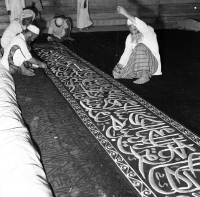
1927 The Founding King Abdulaziz Bin Abdulrahman Al Saud ordered the establishment of a dedicated facility for producing Al-Kaaba Al-Musharrafa's Kiswa in Ajyad district of Makkah Al-Mukarramah, marking the creation of the first Saudi-made Kiswa produced in Makkah Al-Mukarramah. 1962 Al-Kaaba Al-Musharrafa's Kiswa Factory was relocated to Jarwal Neighborhood in Makkah Al-Mukarramah. 1965 The first machine-made Kiswa for Al-Kaaba Al-Musharrafa was produced. 1972 King Faisal Bin Abdulaz...
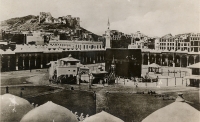
The oldest audio recording of Quran recitation in the Grand Mosque in Makkah Al-Mukarramah , located west of the Kingdom of Saudi Arabia, dates back to 1885. It was recorded by the Dutch Orientalist and Muslim convert Christiaan Snouck Hurgronje using wax cylinders during his visit to Makkah Al-Mukarramah. This recording has been preserved by Leiden University in the Netherlands. ...
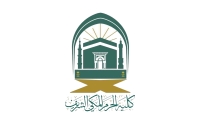
Al-Haram al-Makki College is an Islamic college located in the Grand Mosque in Makkah al-Mukarramah City , west of the Kingdom of Saudi Arabia. It is overseen by the General Authority for the Care of the Affairs of the Grand Mosque and the Prophet's Mosque. Graduates of al-Haram al-Makki Institute are given priority for admission, and students study at the undergraduate level. Establishment of al-Haram al-Makki College Al-Haram al-Makki College was established in 2015 under its new name af...
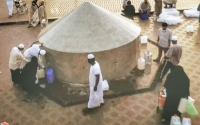
Zamzam water springs from Zamzam Well in the Grand Mosque in Makkah al-Mukarramah near al-Kaaba al-Musharrafa. Ultraviolet (UV) rays are used to sterilize Zamzam water by emitting energy generated by low-pressure mercury lamps enclosed in special glass. The process allows light to pass through bacteria, viruses, and microorganisms, penetrating their outer membranes and destroying their Deoxyribonucleic acid (DNA). The water is then directed into a cylindrical tube containing lamps that generate...
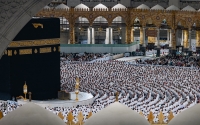
Seclusion (I'tikaf) in the Grand Mosque is a period of seclusion observed by worshippers who dedicate themselves to worship, remembrance, and recitation of the Quran, following the tradition of Prophet Muhammad, peace be upon him (PBUH). It begins in the last ten days of the month of Ramadan, from the twentieth day until the end of the Isha prayer on the night of Eid Al-Fitr. Organizing seclusion in the Grand Mosque The General Authority for the Care of the Affairs of the Grand Mosque and ...
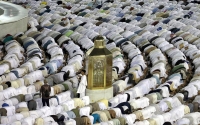
Maqam Ibrahim is the ancient stone upon which Prophet Ibrahim, peace be upon him (PBUH), stood during the construction of Al-Kaaba Al-Musharrafa in Makkah Al-Mukarramah . The stone has undergone several developments and improvements over time, including: 777 The Maqam was adorned with a gold coating for the first time by the Abbasid Caliph Al-Mahdi. 851 The Maqam was gilded for the second time by Al-Mutawakkil ala Allah. 865 It was also gilded during the caliphate of Al-Mutawakkil, and in 870,�...
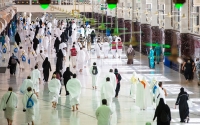
Al-Masa'a in the Grand Mosque in Makkah al-Mukarramah , west of the Kingdom of Saudi Arabia, spans a length of 375 m. It marks the distance between Safa and Marwa mountains, where the Sa'i ritual during Hajj and Umrah begins and ends. Al-Masa'a width is around forty m. Al-Masa'a consists of four floors, covering a total area of 87,000 m 2 . Al-Masa'a area and facilities cover a total area of around 125,000 m 2 . Facilities available in the area include a track of electr...
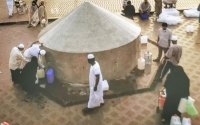
Zamzam water goes through multiple stages from its emergence from the well located in the Grand Mosque in Makkah al-Mukarramah City in the Kingdom of Saudi Arabia, until it reaches the beneficiaries among pilgrims, visitors, and Umrah performers. These stages are: . Extraction from the well via two large pumps with a capacity of 360 m³ per hour. . Transporting the extracted water from the two pumps through water transmission lines made of (stainless steel), reaching a length of four km. . St...
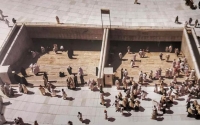
1953 The Founding King Abdulaziz Bin Abdulrahman Al Saud ordered the installation of a pump on Zamzam Well to lift water into two upper tanks made of zinc. He also ordered the installation of twelve taps on each tank, to be used with buckets according to preference. 1962 King Saud Bin Abdulaziz Al Saud issued a Royal Order to expand the Mataf . As a result of this expansion, the opening of the Zamzam Well was lowered below the Mataf level, into a 2.7 m deep basement. This basement was divided i...
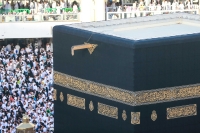
The second renovation of al-Kaaba al-Musharrafa in the Grand Mosque , conducted in 1997 during the Saudi era, comprised several stages, as follows: The roof was removed along with the holding materials placed within the spacers between the main stones. The filling and internal stones were removed, numbered, washed, and cleaned. Spacers were covered with highly efficient holding materials, ensuring adhesivity to stones. Metal pieces were used to bind the stones of the external facade and interio...
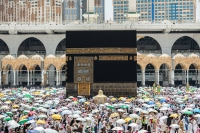
- Three wooden pillars supporting the roof of al-Kaaba al-Musharrafa. - Marble plaque bearing King Fahd document referring to the renovation of al-Kaaba al-Musharrafa. - Suspended runner between the three pillars bearing some of the gifts offered to al-Kaaba al-Musharrafa. - Nine marble stones fixed upon the wall and featuring Thuluth script, except for one in Kufic script. - A silk curtain covering the wall and ceiling, embroidered with the Shahada and some of the holy names of Allah. - Bab al...
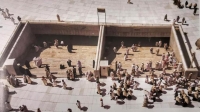
Zamzam Well is located within the Mataf area in the Grand Mosque in Makkah al-Mukarramah . It is positioned on the eastern side of al-Kaaba al-Musharrafa , approximately twenty-one m away, and aligns with al-Multazam . Prophet Muhammad, peace be upon him (PBUH), described Zamzam Water as a blessed water and a cure for illnesses. Al-Azraqi described Zamzam Well in his time as 'the depth of Zamzam from top to bottom was sixty cubits, and at its bottom, there were three springs: one spring ne...